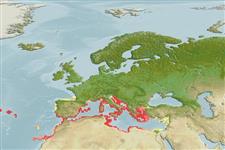>
Eupercaria/misc (Various families in series Eupercaria) >
Labridae (Wrasses)
Etymology: Symphodus: Greek, syn, symphysis = grown together + Greek, odous = teeth (Ref. 45335).
More on author: Linnaeus.
Environment: milieu / climate zone / depth range / distribution range
นิเวศวิทยา
เกี่ยวกับทะเล,น้ำเค็ม สัตว์น้ำหน้าดิน; ระดับความลึก 1 - 50 m (Ref. 5292). Subtropical; 45°N - 32°N, 32°W - 36°E
Eastern Atlantic: Portugal to northern Morocco, including Azores and Madeira and also throughout the Mediterranean.
Length at first maturity / ขนาด / น้ำหนัก / Age
Maturity: Lm 9.0 range ? - ? cm
Max length : 18.0 cm SL เพศผู้/กระเทย; (Ref. 4742); common length : 12.0 cm SL เพศผู้/กระเทย; (Ref. 4742); อายุสูงสุดที่ได้รายงาน: 8 ปี (Ref. 4742)
Adults are found mainly in eel-grass beds. Often in pairs. Males nest-makers. Feed mainly on mollusks, gastropods, bivalves, tubicolous worms, chitons, sea urchins and bryozoans (Ref. 4742). Oviparous, distinct pairing during breeding (Ref. 205).
Life cycle and mating behavior
Maturities | การสืบพันธุ์ | Spawnings | Egg(s) | Fecundities | ตัวอ่อน
Oviparous, distinct pairing during breeding (Ref. 205). Males build dish shaped nests and guard the eggs (Ref. 205).
Quignard, J.-P. and A. Pras, 1986. Labridae. p. 919-942. In P.J.P. Whitehead, M.-L. Bauchot, J.-C. Hureau, J. Nielsen and E. Tortonese (eds.) Fishes of the north-eastern Atlantic and the Mediterranean. UNESCO, Paris. Vol. 2. (Ref. 4742)
IUCN Red List Status (Ref. 130435)
Threat to humans
Harmless
Human uses
การประมง: การประมงยังชีพ; การตกปลาเป็นกีฬา: ใช่; สถานที่แสดงสัตว์และพืชน้ำ: การค้า
เครื่องมือ
Special reports
Download XML
แหล่งที่มาจากอินเตอร์เน็ต
Estimates based on models
Preferred temperature (Ref.
123201): 16.2 - 21, mean 18.5 °C (based on 106 cells).
Phylogenetic diversity index (Ref.
82804): PD
50 = 0.5005 [Uniqueness, from 0.5 = low to 2.0 = high].
Bayesian length-weight: a=0.00977 (0.00779 - 0.01225), b=3.06 (3.02 - 3.10), in cm total length, based on LWR estimates for this species (Ref.
93245).
ระดับชั้นอาหาร (Ref.
69278): 3.2 ±0.2 se; based on diet studies.
Generation time: 2.3 ( na - na) years. Estimated as median ln(3)/K based on 2
growth studies.
ความสามารถในการกลับคืนสู่ปกติ (Ref.
120179): ขนาดกลาง, เวลาต่ำสุดที่จะทำให้ประชากรเพิ่มขึ้นเป็น 2 เท่าใช้เวลา 1.4 - 4.4 ปี (K=0.47-0.63; tm=2-3; tmax=8).
Fishing Vulnerability (Ref.
59153): Low vulnerability (23 of 100).
Nutrients (Ref.
124155): Calcium = 158 [83, 343] mg/100g; Iron = 1.47 [0.72, 3.01] mg/100g; Protein = 18.4 [15.5, 20.4] %; Omega3 = 0.384 [0.230, 0.669] g/100g; Selenium = 20.6 [11.1, 41.6] μg/100g; VitaminA = 18.2 [5.6, 70.8] μg/100g; Zinc = 1.14 [0.78, 1.94] mg/100g (wet weight);
